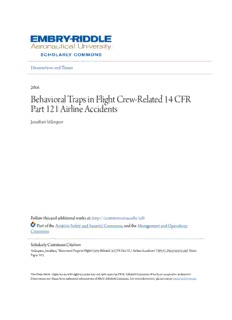
Behavioral Traps in Flight Crew-Related 14 CFR Part 121 Airline Accidents PDF
Preview Behavioral Traps in Flight Crew-Related 14 CFR Part 121 Airline Accidents
PhD Dissertations and Master's Theses 2016 BBeehhaavviioorraall TTrraappss iinn FFlliigghhtt CCrreeww--RReellaatteedd 1144 CCFFRR PPaarrtt 112211 AAiirrlliinnee AAcccciiddeennttss Jonathan Velázquez Follow this and additional works at: https://commons.erau.edu/edt Part of the Aviation Safety and Security Commons, and the Management and Operations Commons SScchhoollaarrllyy CCoommmmoonnss CCiittaattiioonn Velázquez, Jonathan, "Behavioral Traps in Flight Crew-Related 14 CFR Part 121 Airline Accidents" (2016). PhD Dissertations and Master's Theses. 193. https://commons.erau.edu/edt/193 This Dissertation - Open Access is brought to you for free and open access by Scholarly Commons. It has been accepted for inclusion in PhD Dissertations and Master's Theses by an authorized administrator of Scholarly Commons. For more information, please contact [email protected]. BEHAVIORAL TRAPS IN FLIGHT CREW-RELATED 14 CFR PART 121 AIRLINE ACCIDENTS by Jonathan Velázquez A Dissertation Submitted to the College of Aviation in Partial Fulfillment of the Requirements for the Degree of Doctor of Philosophy in Aviation Embry-Riddle Aeronautical University Daytona Beach, Florida March 2016 © 2016 Jonathan Velázquez All Rights Reserved ABSTRACT Researcher: Jonathan Velázquez Title: BEHAVIORAL TRAPS IN FLIGHT CREW-RELATED 14 CFR PART 121 AIRLINE ACCIDENTS Institution: Embry-Riddle Aeronautical University Degree: Doctor of Philosophy in Aviation Year: 2016 This dissertation examined pilot behavioral traps in the multi-crew Part 121 air carrier environment. Behavioral traps are accident-inducing operational pitfalls aviators may encounter as a result of poor decision making. The traps studied were: Loss of Situational Awareness; Neglect of Flight Planning, Preflight Inspections and Checklists; Peer Pressure; Get-There-Itis; and Unauthorized Descent Below an Instrument Flight Rule (IFR) Altitude. The purpose of this dissertation was to study the nature of their occurrence in the airline domain. Another key component was to explore the relationships between the behavioral traps and factors such as pilot age, pilot flight experience, weather, flight conditions, time of day, and the first officer certification level. The dissertation was conducted using an archival combined-methods methodology. Four subject matter experts analyzed 34 National Transportation Safety Board (NTSB) accident reports. Behavioral traps were found in all accidents with Loss of Situational Awareness and Neglect of Flight Planning, Preflight Inspections, and Checklists dominant. The SMEs were able to identify many pilot actions that were representative of the behavioral traps. iii During the qualitative analysis, various themes began to emerge which played important roles in many accidents. These emerging themes were Crew Resource Management issues, Fatigue, Airline Management, and Flying Outside the Envelope. The quantitative analysis discovered a moderate correlation, r = -.34, p = .05, between the Captain’s Flight Experience and the behavioral trap Unauthorized Descent Below an IFR Altitude. No other correlations were found to be significant between the variables and the behavioral traps. The findings of this study indicated that behavioral traps were prevalent in airline accidents including habitual noncompliance by pilots. Further research should focus on other flight domains and other informational sources such as air taxi operators, incident accounts, and flight recorded data. Attitude management training is recommended. iv DEDICATION My journey to a doctoral degree began more than four years ago. This dissertation is dedicated to Amos. I trust the time and effort spent completing this manuscript was part of your plan. With your guidance, everything is possible. To my parents, Israel Velázquez and Sonia I. Rivera, who inspired me to persevere and pursue the highest goals in life. Without their moral and financial support, the road and destination would have been different. v ACKNOWLEDGEMENTS Many thanks to the four subject matter experts: Kevin Roman, Omar Carle, Oswart Mora, and Pablo Ortiz whom collaborated in this research project. Your outstanding participation was key in the completion of this dissertation. Many thanks to Dissertation Chair Dr. Tim Brady. Your attention to detail and unwavering support to my study was crucial. From the moment I took your course in the doctoral program, I knew I wanted you on my team. Thanks for accepting to work with me, even when you became the university’s chancellor and your duties increased exponentially. Also, thank you for helping me become a better writer. Thanks to dissertation committee members Drs. Andy Dattel, Dennis Vincenzi, and Paul Craig. Dr. Dattel, thank you for your statistical support and for answering my messages even after midnight. You rock! Dr. Vincenzi, without your insightful perspective, this dissertation would not be what it is. Thank you for pushing me forward. Dr. Craig, thank you for participating in my research. Who would have thought that our paths would cross again almost 17 years later? Many thanks to my advisor Dr. Haydee Cuevas. You are the reason I have been able to stay airborne during my Ph.D. journey. You are my advisor, but even better, my mentor and friend. I would have to write another dissertation to fully express my gratitude toward you. Dr. Alan Stolzer, thank you for instilling the necessary research interest in all of us, for believing in my research, and for encouraging that I publish. I hope you can see that it has worked. vi To all my classmates, especially: Nicole Bier, Timothy Sestak, Al Peck, and Susan Archer. Nicole, it was fun, and enlightening, working and publishing with you. I hope we can do it again, my friend. Thank you Uncle Al and Timothy for accepting to follow me through with my pilot study in our mixed-methods statistics course. Thank you Susan for those fun residency study moments and collaboration in the various courses. Finally, many thanks to my colleagues Mario Signoret, Maria Franqui, and Carole Gelpí. When I was your undergraduate student, you saw a potential in me that I had not seen. Thank you for suggesting a career in research and education and for believing I could go all the way. vii
Description: